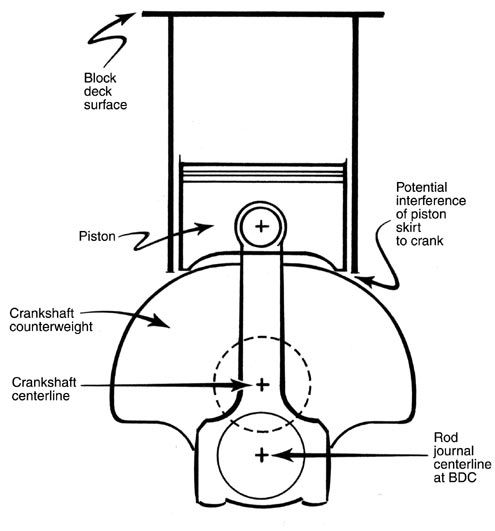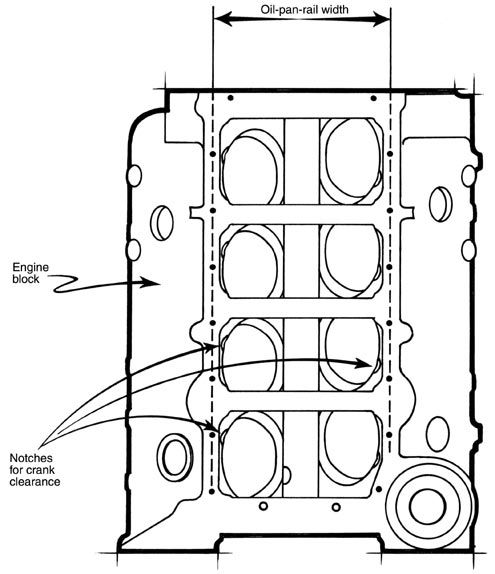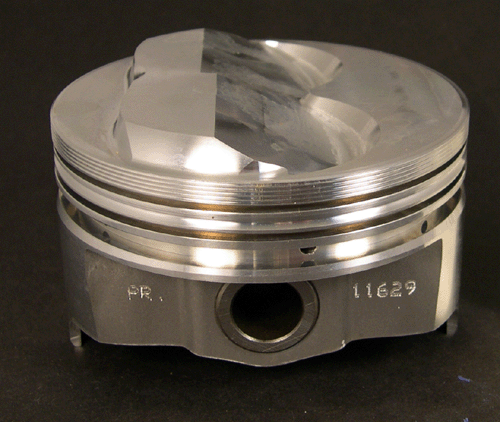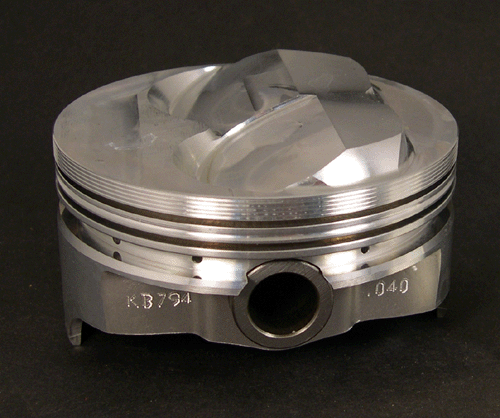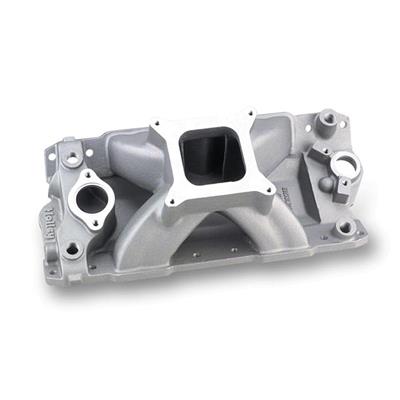My goal with this combination was to have a powerful engine with good street manners for my street rod, something that not only had show but go as well. So I settled on a 383 with the following combination of parts:
Eagle SIR 6.0 inch connecting rods
Eagle cast steel crankshaft
SRP forged flat top pistons
CompCams 280 Magnum flat tappet hydraulic cam (230/230 duration @.050, 480/480 lift)
AFR 190 heads (68cc chambers)
CompCams ProMagnum roller rocker arm (1.52)
Edelbrock RPM intake manifold
Edelbrock 750 carb
MSD Pro Billet distributor with MSD wires
This combination resulted in a static compression of 10.6:1 and a dynamic compression ratio of 8.46. I have never had any problems running 92-93 octane pump gas. The best dyno run was made with total timing set at 32 degrees. I think this is a good example of how good breathing heads can make excellent power even with a street-friendly cam. See below:
RPM TORQ PWR BSFC OIL T WAT T C.F. A Den Fuel F TIME
BAND Ft-Lbs CHP #/HrHP Deg F Deg F 100 % #/Hr SEC
3148 432.5 264.7 0.532 75.0 186 1.071 92.0 127.4 1.9
3200 441.5 268.7 0.521 75.0 186 1.071 92.0 126.8 16.9
3300 439.4 275.9 0.502 74.5 187 1.071 92.0 125.3 7.3
3400 435.3 282.0 0.485 74.5 187 1.071 92.0 123.7 3.5
3500 437.4 291.2 0.474 74.5 187 1.071 92.0 125.0 3.4
3600 438.4 300.4 0.463 74.5 187 1.071 92.0 125.8 3.3
3700 440.4 310.6 0.453 74.5 187 1.071 92.0 127.0 1.6
3800 443.6 320.9 0.440 74.5 187 1.071 92.0 127.7 3.2
3900 446.6 332.1 0.428 74.5 187 1.071 92.0 128.3 1.5
4000 455.1 346.4 0.409 74.5 187 1.071 92.0 127.9 1.5
4100 462.9 360.7 0.468 74.5 188 1.071 92.0 135.7 1.5
4200 463.1 376.0 0.418 74.5 188 1.071 92.0 141.9 1.4
4300 467.7 387.3 0.422 75.0 188 1.071 92.0 147.9 1.4
4400 467.0 395.5 0.430 74.5 188 1.071 92.0 153.8 2.7
4500 466.1 403.6 0.438 74.5 188 1.071 92.0 159.7 2.7
4600 463.0 410.8 0.451 74.5 188 1.071 92.0 167.2 1.3
4700 460.0 419.0 0.464 75.0 188 1.071 92.0 175.1 2.6
4800 459.0 425.1 0.471 74.5 188 1.071 92.0 180.8 3.8
4900 457.9 431.2 0.465 74.5 188 1.071 92.0 180.8 2.4
5000 455.8 434.3 0.468 74.5 188 1.071 91.9 183.2 2.4
5100 449.6 434.3 0.470 74.5 188 1.071 91.9 185.0 3.5
5200 449.6 437.4 0.469 74.5 188 1.071 91.9 186.4 3.5
5300 438.4 442.5 0.473 75.0 188 1.071 91.9 188.5 3.4
5400 431.2 443.5 0.481 74.5 188 1.071 92.0 192.1 2.2
5500 423.1 443.5 0.491 74.5 188 1.071 92.0 195.6 4.4
5600 415.9 444.7 0.496 74.5 188 1.071 92.0 198.0 2.1
5700 412.8 449.8 0.496 75.0 189 1.071 92.0 200.1 1.1
5800 397.5 438.4 0.513 75.0 189 1.071 92.0 202.1 3.1
5900 389.3 437.4 0.520 74.5 189 1.071 92.0 204.1 2.0
6000 378.1 431.3 0.533 74.5 189 1.071 92.0 206.0 1.0
6100 373.0 433.3 0.536 74.5 189 1.071 92.0 208.1 2.0
6162 364.8 428.2 0.546 75.0 189 1.071 92.0 209.3 1.0
Eagle SIR 6.0 inch connecting rods
Eagle cast steel crankshaft
SRP forged flat top pistons
CompCams 280 Magnum flat tappet hydraulic cam (230/230 duration @.050, 480/480 lift)
AFR 190 heads (68cc chambers)
CompCams ProMagnum roller rocker arm (1.52)
Edelbrock RPM intake manifold
Edelbrock 750 carb
MSD Pro Billet distributor with MSD wires
This combination resulted in a static compression of 10.6:1 and a dynamic compression ratio of 8.46. I have never had any problems running 92-93 octane pump gas. The best dyno run was made with total timing set at 32 degrees. I think this is a good example of how good breathing heads can make excellent power even with a street-friendly cam. See below:
RPM TORQ PWR BSFC OIL T WAT T C.F. A Den Fuel F TIME
BAND Ft-Lbs CHP #/HrHP Deg F Deg F 100 % #/Hr SEC
3148 432.5 264.7 0.532 75.0 186 1.071 92.0 127.4 1.9
3200 441.5 268.7 0.521 75.0 186 1.071 92.0 126.8 16.9
3300 439.4 275.9 0.502 74.5 187 1.071 92.0 125.3 7.3
3400 435.3 282.0 0.485 74.5 187 1.071 92.0 123.7 3.5
3500 437.4 291.2 0.474 74.5 187 1.071 92.0 125.0 3.4
3600 438.4 300.4 0.463 74.5 187 1.071 92.0 125.8 3.3
3700 440.4 310.6 0.453 74.5 187 1.071 92.0 127.0 1.6
3800 443.6 320.9 0.440 74.5 187 1.071 92.0 127.7 3.2
3900 446.6 332.1 0.428 74.5 187 1.071 92.0 128.3 1.5
4000 455.1 346.4 0.409 74.5 187 1.071 92.0 127.9 1.5
4100 462.9 360.7 0.468 74.5 188 1.071 92.0 135.7 1.5
4200 463.1 376.0 0.418 74.5 188 1.071 92.0 141.9 1.4
4300 467.7 387.3 0.422 75.0 188 1.071 92.0 147.9 1.4
4400 467.0 395.5 0.430 74.5 188 1.071 92.0 153.8 2.7
4500 466.1 403.6 0.438 74.5 188 1.071 92.0 159.7 2.7
4600 463.0 410.8 0.451 74.5 188 1.071 92.0 167.2 1.3
4700 460.0 419.0 0.464 75.0 188 1.071 92.0 175.1 2.6
4800 459.0 425.1 0.471 74.5 188 1.071 92.0 180.8 3.8
4900 457.9 431.2 0.465 74.5 188 1.071 92.0 180.8 2.4
5000 455.8 434.3 0.468 74.5 188 1.071 91.9 183.2 2.4
5100 449.6 434.3 0.470 74.5 188 1.071 91.9 185.0 3.5
5200 449.6 437.4 0.469 74.5 188 1.071 91.9 186.4 3.5
5300 438.4 442.5 0.473 75.0 188 1.071 91.9 188.5 3.4
5400 431.2 443.5 0.481 74.5 188 1.071 92.0 192.1 2.2
5500 423.1 443.5 0.491 74.5 188 1.071 92.0 195.6 4.4
5600 415.9 444.7 0.496 74.5 188 1.071 92.0 198.0 2.1
5700 412.8 449.8 0.496 75.0 189 1.071 92.0 200.1 1.1
5800 397.5 438.4 0.513 75.0 189 1.071 92.0 202.1 3.1
5900 389.3 437.4 0.520 74.5 189 1.071 92.0 204.1 2.0
6000 378.1 431.3 0.533 74.5 189 1.071 92.0 206.0 1.0
6100 373.0 433.3 0.536 74.5 189 1.071 92.0 208.1 2.0
6162 364.8 428.2 0.546 75.0 189 1.071 92.0 209.3 1.0

